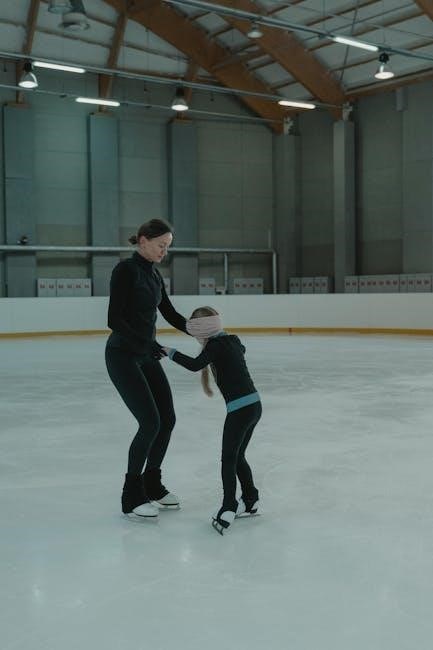
Osgood-Schlatter Disease is a common overuse injury affecting the tibial tubercle‚ typically in adolescents during growth spurts. It causes knee pain and swelling‚ often self-limiting but manageable with rest‚ ice‚ and targeted exercises for recovery.
1.1 Definition and Overview
Osgood-Schlatter Disease is a common overuse injury affecting the tibial tubercle‚ causing knee pain and swelling. It typically occurs in adolescents during growth spurts‚ especially in active individuals. The condition is characterized by inflammation of the patellar tendon’s attachment point on the shinbone. While it is self-limiting‚ symptoms can be managed with rest‚ ice‚ and structured exercises. Early intervention and proper rehabilitation are crucial to prevent long-term discomfort and ensure full recovery.
1.2 Demographics and Common Causes
Osgood-Schlatter Disease primarily affects adolescents aged 8-14‚ particularly during rapid growth spurts. It is more common in active individuals involved in sports requiring frequent running‚ jumping‚ or repetitive knee movements. Males are historically more affected‚ though cases in females are rising. The condition arises from repetitive stress on the patellar tendon‚ leading to inflammation at the tibial tubercle. Overuse‚ tight quadriceps‚ and poor biomechanics are key contributors‚ making it a prevalent issue in young athletes.
Symptoms of Osgood-Schlatter Disease
Osgood-Schlatter Disease symptoms include knee pain‚ swelling‚ and tenderness below the kneecap. Inflammation at the tibial tubercle worsens with activity and improves with rest.
2.1 Common Symptoms
Osgood-Schlatter Disease typically presents with knee pain‚ swelling‚ and tenderness below the kneecap. Pain worsens during activities like running‚ jumping‚ or climbing stairs. Swelling and inflammation at the tibial tubercle are common‚ and the area may feel warm to the touch. Symptoms often fluctuate‚ improving with rest and worsening with repetitive stress. In some cases‚ a visible bump may develop at the site of inflammation. These symptoms are most prevalent in adolescents during growth spurts.
2.2 Pain Management Strategies
Pain management for Osgood-Schlatter Disease often involves the RICE method: Rest‚ Ice‚ Compression‚ and Elevation. Ice therapy‚ applied for 10-15 minutes several times a day‚ helps reduce swelling. Activity modification is crucial‚ avoiding high-impact activities that exacerbate pain. Gentle stretching and strengthening exercises‚ as outlined in rehabilitation protocols‚ can alleviate discomfort. Over-the-counter pain relievers may be used‚ but nonsteroidal anti-inflammatory drugs should be avoided during healing. Combining rest with targeted exercises ensures effective pain relief and supports recovery.

Importance of Exercise in Managing Osgood-Schlatter Disease
Exercise plays a crucial role in managing Osgood-Schlatter Disease by reducing pain‚ improving knee function‚ and promoting recovery through targeted strengthening and stretching routines.
3.1 Role of Exercise in Rehabilitation
Exercise is vital in rehabilitating Osgood-Schlatter Disease by enhancing strength‚ improving knee function‚ and reducing pain. It includes targeted strengthening‚ stretching‚ and corrective exercises tailored to individual needs. These routines‚ guided by clinicians‚ help restore mobility and prevent further injury. Consistency is key‚ with exercises performed regularly to promote healing without overloading the knee. This balanced approach supports recovery and helps patients return to normal activities effectively.
3.2 Benefits of a Structured Exercise Program
A structured exercise program for Osgood-Schlatter Disease offers numerous benefits‚ including improved knee stability‚ reduced pain‚ and enhanced functional mobility. It promotes proper healing‚ prevents further injury‚ and helps patients gradually return to their normal activities. These programs are tailored to individual needs‚ focusing on strengthening‚ stretching‚ and corrective exercises. Consistency in following the program ensures long-term recovery and reduces the risk of recurrence‚ making it a cornerstone of effective management.
Strengthening Exercises for Osgood-Schlatter Disease
Strengthening exercises target the quadriceps‚ hamstrings‚ and calves to enhance knee stability and reduce pain. Examples include side stepping with bands and heel slides‚ promoting healing without overloading the knee.
4.1 Quadriceps Strengthening Exercises
Quadriceps strengthening exercises are essential for managing Osgood-Schlatter Disease; Straight leg raises‚ mini squats‚ and side stepping with resistance bands target the quadriceps without overloading the knee. These exercises improve knee stability and reduce pain. Perform 2-3 sets of 10-15 repetitions daily‚ ensuring proper form to avoid strain. Progress gradually‚ adding resistance as strength improves. Consistency in these exercises helps restore function and supports long-term recovery‚ making them a cornerstone of rehabilitation programs for Osgood-Schlatter Disease.
4.2 Hamstring Strengthening Exercises
Hamstring strengthening exercises complement quadriceps work in Osgood-Schlatter Disease management. Seated leg curls‚ glute-ham raises‚ and heel slides are effective. These exercises improve posterior chain strength‚ reducing knee strain. Perform 2-3 sets of 10-15 repetitions daily‚ focusing on controlled movements. Hamstring exercises enhance knee stability and promote balanced muscle development‚ crucial for recovery. Incorporating these into a structured program helps alleviate symptoms and supports overall knee health‚ making them a vital part of rehabilitation strategies for Osgood-Schlatter Disease.
4.3 Calf Strengthening Exercises
Calf strengthening exercises are essential for managing Osgood-Schlatter Disease‚ as they reduce knee strain and improve lower limb stability. Standing heel raises and seated calf stretches are effective. Perform 2-3 sets of 10-15 repetitions daily. These exercises target the gastrocnemius and soleus muscles‚ enhancing muscle balance and supporting recovery. Proper form and controlled movements are crucial to avoid overloading the knee. Incorporating calf exercises into a structured program helps alleviate symptoms and promotes long-term knee health‚ making them a key component of rehabilitation strategies.
4.4 Core Strengthening Exercises
Core strengthening exercises play a vital role in managing Osgood-Schlatter Disease by improving stability and reducing knee strain. Planks‚ bridges‚ and pelvic tilts are effective for enhancing core muscle strength. These exercises stabilize the lower extremities and promote proper biomechanics. Perform 2-3 sets of 10-15 repetitions daily. Strengthening the core muscles helps distribute forces more evenly‚ reducing pressure on the knee. Proper form and controlled movements are essential to avoid overloading the knee joint. Incorporating core exercises into your routine supports overall knee health and accelerates recovery.
Stretching Exercises for Osgood-Schlatter Disease
Stretching exercises reduce knee tension and improve flexibility. Focus on quadriceps‚ hamstrings‚ and calf muscles. Perform gentle stretches 2-3 times daily to alleviate symptoms and promote recovery.
5.1 Quadriceps Stretching Exercises
Quadriceps stretching is essential for reducing tension in the knee area. Stand with one hand against a wall for balance. Bend one knee‚ keeping the foot behind you‚ until a gentle stretch is felt in the front of your leg. Hold for 20-30 seconds and repeat 2-3 times on each side. This exercise helps alleviate tightness and improves flexibility‚ which is crucial for managing Osgood-Schlatter Disease symptoms effectively.
5.2 Hamstring Stretching Exercises
Hamstring stretches are vital for improving flexibility and reducing knee strain. Sit on the floor with your legs straight out in front of you. Lean forward gently from your hips until you feel a stretch in the back of your thighs. Hold for 20-30 seconds and repeat 2-3 times. For a deeper stretch‚ loop a towel around your feet and pull back; Perform daily to enhance mobility and support recovery from Osgood-Schlatter Disease.
5.3 Calf Stretching Exercises
Calf stretches help improve lower leg flexibility‚ reducing tension on the knee. Stand facing a wall with one hand on it for balance. Step one foot back about a foot‚ keeping your heel on the ground. Bend the front knee slightly and lean forward until you feel a stretch in your calf. Hold for 20-30 seconds‚ then switch legs. Repeat 2-3 times daily. For a deeper stretch‚ use a towel to pull your foot upward while seated.
5.4 Hip Flexor Stretching Exercises
Hip flexor stretches are essential for improving flexibility and reducing knee tension. Kneel on one knee with the other foot in front‚ keeping your back straight. Slowly push your hips forward until you feel a stretch in the front of your hip. Hold for 20-30 seconds‚ then switch sides. Perform 2-3 sets daily. This stretch helps alleviate tightness that can contribute to knee discomfort‚ promoting better overall lower limb alignment and movement.

Corrective Exercises for Osgood-Schlatter Disease
Corrective exercises focus on improving knee alignment and strength. Side stepping with bands and heel slides are effective for addressing muscle imbalances and enhancing proper movement patterns.
6.1 Gait Training and Biomechanical Corrections
Gait training focuses on correcting walking patterns to reduce stress on the knee. Exercises like side stepping with bands and heel slides improve alignment and strength. Using a mirror to monitor form ensures proper technique. A physiotherapist can tailor these exercises‚ addressing individual biomechanical issues and promoting proper movement patterns. This approach helps restore normal gait‚ reduce pain‚ and prevent further injury‚ aiding in the recovery process for Osgood-Schlatter Disease.
6.2 Balance and Proprioception Exercises
Balance and proprioception exercises are crucial for improving stability and reducing knee strain. Activities like single-leg stands‚ wobble board training‚ and heel-to-toe walking enhance neuromuscular control. These exercises help restore proper joint awareness and alignment‚ reducing pain and improving functional movement. A physiotherapist can tailor these exercises to address specific imbalances‚ ensuring a comprehensive approach to rehabilitation and long-term recovery from Osgood-Schlatter Disease.
6.3 Functional Movement Training
Functional movement training focuses on improving coordination and strength for daily activities and sports. Exercises like step-ups‚ balance drills‚ and dynamic lunges enhance neuromuscular control. These movements mimic real-life actions‚ helping restore normal movement patterns and reduce knee strain. By addressing muscle imbalances and poor mechanics‚ functional training reduces the risk of re-injury and improves overall athletic performance. A structured program tailored by a physiotherapist ensures progress and long-term recovery from Osgood-Schlatter Disease.

Activity Modification for Osgood-Schlatter Disease
Activity modification involves reducing high-impact activities and avoiding overloading the knee to manage symptoms. This includes adjusting exercise intensity and avoiding repetitive stress on the tibial tubercle.
7.1 Reducing Load on the Knee
Reducing load on the knee is crucial to manage Osgood-Schlatter Disease. This involves avoiding high-impact activities‚ such as jumping or running‚ and minimizing repetitive stress on the tibial tubercle. Patients are advised to modify their exercise routines‚ opting for low-impact alternatives like swimming or cycling. Using supportive devices‚ such as knee braces‚ can also help alleviate strain. While complete rest is not recommended‚ as it may lead to stiffness‚ reducing activity intensity and frequency is essential to promote healing and prevent further irritation of the affected area.
7.2 Avoiding High-Impact Activities
Avoiding high-impact activities is essential to prevent further irritation and promote healing in Osgood-Schlatter Disease. Activities like running‚ jumping‚ and sports involving repetitive knee stress should be minimized or avoided. Instead‚ low-impact exercises such as swimming‚ cycling‚ or using an elliptical machine are recommended; These alternatives reduce strain on the knee while maintaining physical fitness. Consulting with a healthcare provider or physical therapist can help tailor activity modifications to individual needs‚ ensuring proper recovery and minimizing the risk of recurrence.

Role of Physical Therapy in Osgood-Schlatter Disease
Physical therapy plays a crucial role in managing Osgood-Schlatter Disease by providing personalized exercise programs and manual therapy techniques to reduce pain‚ improve mobility‚ and promote recovery without surgery.
8.1 Customized Exercise Programs
Customized exercise programs are tailored to address individual needs‚ focusing on strengthening and stretching muscles around the knee. These programs often include quadriceps‚ hamstring‚ and calf exercises to improve joint stability and reduce pain. A physiotherapist designs these plans based on the patient’s condition‚ ensuring exercises are performed correctly to avoid further injury. The programs typically involve 2-3 sets of 10-15 repetitions‚ with a focus on low-impact movements to promote healing without exacerbating symptoms. Regular progression and monitoring are essential for optimal recovery.
8.2 Manual Therapy Techniques
Manual therapy techniques‚ such as soft tissue massage and joint mobilization‚ are often used to reduce muscle tightness and improve joint mobility in Osgood-Schlatter Disease. Physiotherapists may employ foam rolling or hands-on methods to release tension in the quadriceps and hamstrings‚ which can contribute to knee pain. These techniques aim to enhance blood flow‚ reduce inflammation‚ and restore normal movement patterns. When combined with exercise‚ manual therapy can accelerate recovery and improve functional outcomes for patients with this condition.

Osgood-Schlatter Disease Exercise PDF Resources
Downloadable PDF guides provide detailed exercise programs‚ stretching routines‚ and recovery tips for managing Osgood-Schlatter Disease. These resources are accessible online and offer structured rehabilitation plans for patients.
9.1 Top Recommended PDF Guides
Top-rated PDF guides for Osgood-Schlatter Disease offer comprehensive exercise programs‚ including stretching‚ strengthening‚ and rehabilitation routines. These resources‚ often provided by orthopedic clinics and physical therapy centers‚ are free to download and include detailed instructions‚ diagrams‚ and progress tracking. They emphasize low-impact activities‚ proper technique‚ and gradual progression to ensure safe and effective recovery. Many guides are tailored for adolescents and young athletes‚ addressing growth-related challenges and promoting long-term knee health. Always consult a healthcare professional before starting any new exercise program.
9.2 How to Access and Utilize These Resources
Accessing Osgood-Schlatter Disease exercise PDFs is straightforward. Visit official orthopedic or physical therapy websites‚ or search engines using keywords like “Osgood-Schlatter exercises PDF.” Many resources are free to download and include detailed exercise routines. Print or save the guides for easy reference. Use them alongside professional guidance to ensure proper technique and progression. These resources often include visual aids and step-by-step instructions‚ making them user-friendly for patients and caregivers. Regularly update your routine based on the guide’s recommendations to optimize recovery.

Pain Management Through Exercise
Exercise helps manage Osgood-Schlatter Disease pain by strengthening muscles and improving flexibility. Techniques like ice therapy‚ rest‚ and low-impact activities reduce inflammation and promote healing.
10.1 Ice Therapy and Rest
Ice therapy and rest are essential for managing Osgood-Schlatter Disease. Applying ice to the affected area for 10-15 minutes several times a day helps reduce swelling and pain. Rest allows the tibial tubercle to heal‚ though complete immobilization is rarely needed. Modifying activities to avoid overloading the knee is crucial. Combining ice therapy with structured rest and exercise programs can significantly alleviate symptoms and promote recovery.
10.2 Low-Impact Aerobic Exercises
Low-impact aerobic exercises‚ such as swimming‚ cycling‚ or using an elliptical machine‚ are beneficial for managing Osgood-Schlatter Disease. These activities improve circulation‚ strengthen muscles‚ and maintain fitness without putting excessive stress on the knee. They should be performed at a moderate intensity to avoid aggravating the condition. Consistency is key‚ as these exercises help promote healing and overall physical function while reducing the risk of further injury.

Exercises to Avoid with Osgood-Schlatter Disease
High-impact activities‚ deep knee bends‚ and repetitive jumping should be avoided to prevent worsening symptoms. These exercises can increase stress on the knee‚ delaying recovery.
11.1 High-Impact Activities to Avoid
High-impact activities like running‚ jumping‚ and repetitive knee bending should be avoided to prevent worsening symptoms. These activities increase stress on the knee‚ potentially delaying recovery. Reducing load on the knee is crucial‚ though complete rest isn’t advised. Instead‚ focus on low-impact exercises and strengthening programs to manage the condition effectively.
11.2 Overstretching and Overloading
Overstretching and overloading the knee can worsen Osgood-Schlatter symptoms. Activities that involve excessive knee bending or stretching should be avoided‚ as they strain the tibial tubercle. Avoid deep squats‚ lunges‚ or prolonged sitting‚ which can exacerbate pain. Gentle exercises and gradual strengthening are recommended instead. Sharp pain during activities is a sign to stop and rest. Prioritizing low-impact movements helps protect the knee and promotes healing without overloading the affected area.

Success Stories and Case Studies
Many individuals with Osgood-Schlatter Disease have achieved full recovery through consistent exercise and activity modification. Real-life examples highlight the effectiveness of structured rehabilitation programs in reducing symptoms and restoring function.
12.1 Real-Life Examples of Recovery
A 14-year-old athlete with Osgood-Schlatter Disease experienced significant improvement by following a structured exercise program. Incorporating side-stepping exercises with resistance bands and quadriceps strengthening‚ they reduced knee pain and returned to sports. Consistency in performing daily exercises‚ along with activity modification‚ played a key role in their recovery. This case highlights how tailored rehabilitation can effectively manage symptoms and restore function‚ allowing individuals to resume normal activities without persistent discomfort.
12.2 Lessons Learned from Successful Rehabilitation
Successful rehabilitation emphasizes consistency in structured exercise programs‚ focusing on strengthening and stretching. Activity modification and avoiding high-impact activities are crucial during recovery. Professional guidance from physiotherapists ensures personalized approaches‚ addressing individual needs. Monitoring progress and adjusting exercises as symptoms improve is vital. Patience and adherence to rehabilitation protocols significantly enhance outcomes‚ allowing individuals to regain full functionality and reduce recurrence risk. These strategies underscore the importance of a holistic approach in managing Osgood-Schlatter Disease effectively.
Effective management of Osgood-Schlatter Disease combines targeted exercises‚ activity modification‚ and professional guidance‚ leading to successful recovery and long-term knee health.
13.1 Summary of Key Points
Osgood-Schlatter Disease is a common knee condition in adolescents‚ causing pain and swelling below the kneecap. It often results from overuse during growth spurts. Key management strategies include rest‚ ice therapy‚ and structured exercise programs focusing on strengthening and stretching the quadriceps‚ hamstrings‚ and calves. Activity modification is crucial to reduce knee stress. Professional guidance from physiotherapists can tailor rehabilitation plans‚ ensuring proper recovery and preventing recurrence. Consistency in exercises and avoiding high-impact activities are vital for long-term relief and knee health.
13.2 Final Thoughts on Effective Management
Effective management of Osgood-Schlatter Disease requires a holistic approach‚ combining rest‚ ice therapy‚ and structured exercise programs. Consistency in performing strengthening and stretching exercises is crucial for recovery. Avoiding high-impact activities and modifying daily routines to reduce knee stress are essential. Professional guidance from physiotherapists ensures personalized rehabilitation plans‚ promoting long-term relief. By adhering to these strategies and utilizing resources like exercise PDF guides‚ individuals can effectively manage symptoms and prevent recurrence‚ fostering optimal knee health and functional recovery.

Resources for Further Reading
Access detailed PDF guides and exercise videos for Osgood-Schlatter Disease management. Explore recommended websites and tutorials for comprehensive rehabilitation strategies and expert advice.
14.1 Recommended Websites and Articles
For comprehensive guidance‚ visit reputable orthopedic and physical therapy websites. OrthoInfo and Physiotherapy Exercises offer detailed exercise plans. Additionally‚ medical journals like Sports Health provide evidence-based strategies. Download the Osgood-Schlatter Disease Exercise Programme PDF from trusted healthcare providers for structured routines. These resources ensure safe and effective rehabilitation‚ helping you manage symptoms and strengthen the knee area properly. Always consult a healthcare professional before starting any new exercise program.
14.2 Suggested Exercise Videos and Tutorials
YouTube channels like AskDoctorJo and Physiotherapy Exercises offer step-by-step videos for Osgood-Schlatter exercises. Websites such as OrthoInfo provide tutorial guides for knee strengthening and stretching. Additionally‚ platforms like Google Classroom host resources for structured exercise programs. These videos and tutorials are designed to help patients perform exercises safely and effectively‚ ensuring proper technique and progression. Always consult a healthcare professional before starting any new exercise program to tailor it to your specific needs.